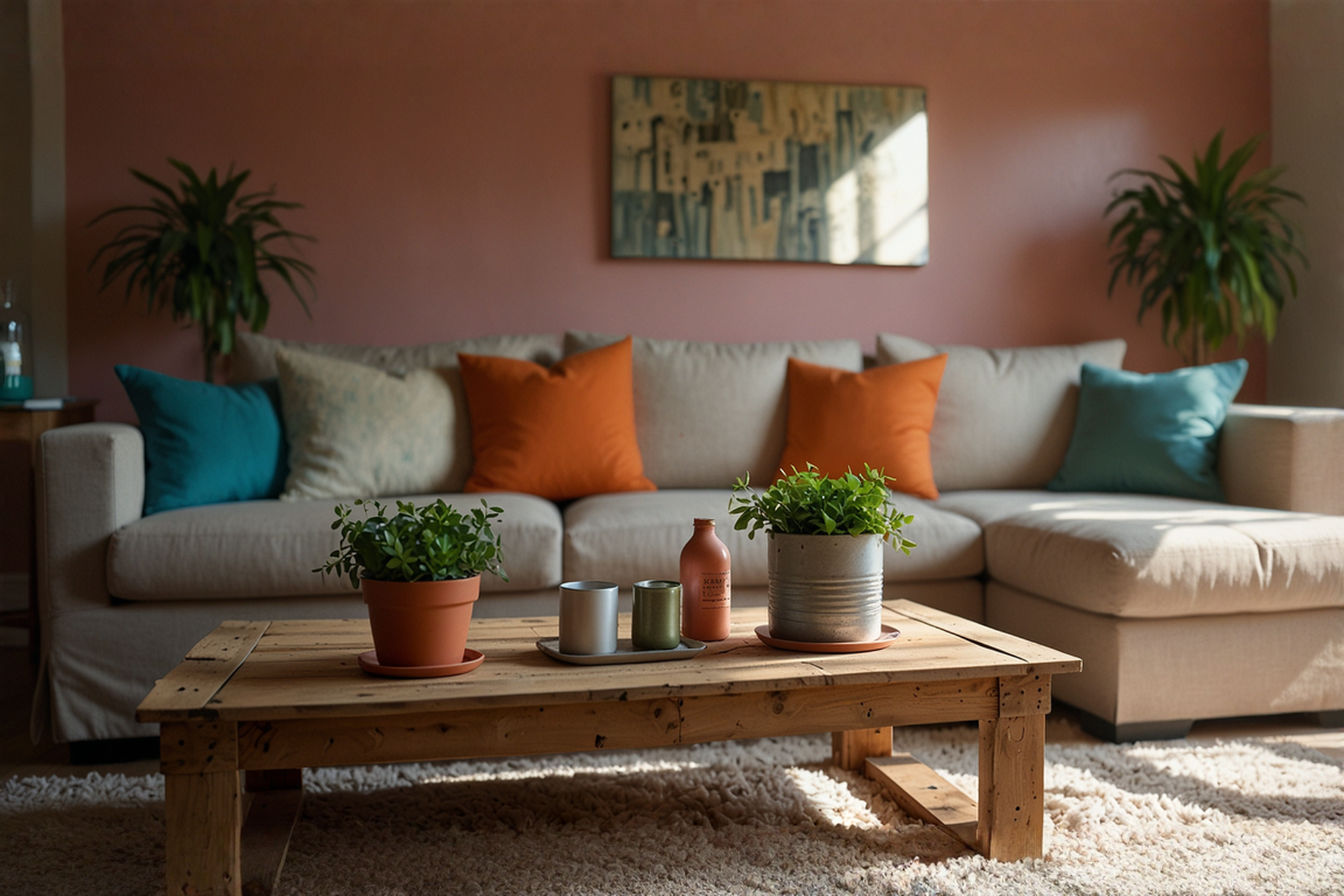This post may contain affiliate links. If you make a purchase through these links, we may earn a commission at no additional cost to you.
In a world of complex DIY projects and expensive home decor, sometimes the most impactful designs come from the simplest materials. Tape painting—a technique where adhesive tape creates clean lines and patterns—offers an accessible entry point into creative expression without requiring advanced artistic skills. This versatile method transforms ordinary surfaces into personalized masterpieces using materials you likely already have at home.
Whether you’re a seasoned DIY enthusiast or a complete beginner, tape painting provides endless possibilities for customization. The magical moment comes when you peel away the tape to reveal crisp, professional-looking designs that belie the simplicity of the process. Throughout this guide, you’ll discover 24 innovative ways to use this humble material to breathe new life into walls, furniture, artworks, and more.
The Basics of Tape Painting
Before diving into specific projects, understanding the fundamentals will set you up for success in all your tape painting endeavors.
Selecting the Right Tape
Not all tapes perform equally in painting projects. Your choice significantly impacts the quality of your finished piece.
Painter’s tape reigns supreme for most applications. Its low-tack adhesive prevents damage to surfaces while creating clean edges. The blue variety works well for short-term projects, while green painter’s tape offers enhanced durability for projects spanning multiple days.
Washi tape, with its decorative patterns and gentle adhesive, provides both functional and aesthetic benefits for smaller craft projects. The delicate nature makes it perfect for paper and light surfaces where regular painter’s tape might cause damage.
Masking tape serves as a budget-friendly alternative, though it risks leaving residue or tearing delicate surfaces upon removal. Reserve this option for rough surfaces or when painter’s tape isn’t available.
Electrical tape brings flexibility and waterproof properties to the table, making it suitable for curved designs and moisture-prone areas. Its narrow width creates fine details that broader tapes cannot achieve.
Essential Tools and Materials
Beyond tape, several key items enhance your tape painting experience:
- Quality paint brushes in various sizes for different application techniques
- Paint rollers for larger surfaces and smoother application
- Acrylic or latex paints compatible with your chosen surface
- Drop cloths to protect surrounding areas
- Utility knife for precise tape cutting
- Level and measuring tape for geometric accuracy
- Pencil for light marking before applying tape
Surface Preparation
Proper preparation forms the foundation of successful tape painting. First, thoroughly clean your surface to remove dust, oils, or debris that might interfere with tape adhesion. For walls, patch any holes and sand rough areas to create a smooth canvas.
When working with new drywall or porous surfaces, apply a primer to create a unified base that prevents uneven paint absorption. Allow all preparatory coats to dry completely before applying tape, as moisture compromises adhesive effectiveness.
Preventing Paint Bleed
Nothing disappoints more than discovering color seepage beneath your carefully placed tape. Prevent this common issue by sealing the tape edges with a thin layer of the base color before applying your feature color. This technique creates a barrier that prevents new paint from migrating under the tape.
Alternatively, burnish the tape edges by running a credit card or plastic tool firmly along the tape to secure its seal against the surface. This simple step dramatically improves line crispness in your final design.
Tape Removal Techniques
Timing proves crucial when removing tape. Pull the tape when the paint feels dry to the touch but before it fully cures. Removing too early causes smearing, while waiting too long risks paint chipping along the edges.
Pull the tape at a 45-degree angle, moving slowly and steadily away from the painted area. For extra precision, score along the tape edge with a utility knife before removal to prevent any lifting of the dried paint.
Wall and Room Painting Ideas
Transform your living spaces with these impactful tape painting techniques that create professional-looking results without the designer price tag.
1. Geometric Accent Wall
Create a focal point in any room by designing a geometric pattern on a single wall. Start with a base coat in your chosen background color, then apply tape in triangular, diamond, or hexagonal arrangements. Paint alternate sections in complementary or contrasting colors for a dynamic visual effect.
This technique works particularly well behind sofas, beds, or dining areas where the dramatic pattern draws the eye without overwhelming the entire space. For smaller rooms, consider larger geometric shapes, while more intricate patterns suit spacious areas.
2. Horizon Line Divider
Modernize your walls with a clean horizontal line that visually expands your space. Apply a long strip of tape at your desired height—typically between one-third and two-thirds up the wall. Paint above or below the line in a contrasting color to create a sophisticated two-tone effect.
This approach works wonderfully in narrow hallways or smaller rooms where vertical stripes might make the space feel confined. The horizontal division tricks the eye into perceiving greater width while adding architectural interest to plain walls.
3. Faux Wainscoting with Tape
Traditional wainscoting adds elegance but requires carpentry skills and significant investment. Create a convincing alternative using tape to outline rectangular panels along the lower portion of your walls. Paint inside these tape boundaries with semi-gloss paint for an authentic wainscoting appearance.
Space your rectangles evenly, maintaining consistent dimensions for a polished look. This technique particularly enhances dining rooms, entryways, and bathrooms with timeless sophistication at a fraction of the cost of wood installation.
4. Patterned Ceiling Design
Draw the eye upward by applying an unexpected pattern to your ceiling. Use tape to create a simple starburst from the light fixture, a grid of squares, or concentric circles. Even basic stripes transform this often-neglected surface into a conversation piece.
Select colors that complement rather than compete with your wall color. Lighter shades prevent the ceiling from feeling lower, while metallic accents add subtle glamour when they catch the light.
5. Door Frame Transformation
Reinvigorate plain interior doors by using tape to create paneling effects or geometric patterns. Apply tape in a symmetrical arrangement, then paint over it with a color that contrasts with your existing door. When the tape comes off, you’ll reveal the original door color in a precise pattern.
This technique breathes new life into older doors without the expense of replacement. The vertical lines naturally draw the eye upward, creating the illusion of higher ceilings throughout your home.
6. Diamond Grid Pattern
Elevate any wall with a sophisticated diamond pattern that suggests high-end wallpaper. Create your grid by placing tape diagonally in both directions, forming consistent diamond shapes across the wall. Apply paint over the tape, then remove to reveal crisp white (or base color) lines between colored diamonds.
This pattern works particularly well in powder rooms, dining areas, or as a focal wall in bedrooms. Adjust the diamond size according to your room dimensions—larger diamonds for spacious areas and smaller ones for more intimate settings.
Canvas and Art Project Ideas
Express your creativity through these tape-based art techniques that transform blank canvases into gallery-worthy pieces without advanced painting skills.
7. Abstract Tape Resist Painting
Begin with a blank canvas and apply tape in random intersecting lines, curves, or geometric shapes. Cover the entire canvas with multiple paint colors, allowing them to blend where they meet. Once dry, remove the tape to reveal clean white lines cutting through the colorful background.
This technique creates sophisticated abstract art suitable for modern interiors. Experiment with complementary colors for vibrant energy or monochromatic schemes for subtle elegance. The unpredictable nature of this approach makes each piece uniquely yours.
8. Gradient Color Blocks
Divide your canvas into sections using horizontal or vertical tape strips. Paint each section with colors that gradually shift from dark to light or between complementary hues. The tape ensures clean transitions between each color block, creating a polished ombré effect.
This methodical approach produces visually striking art that coordinates perfectly with your existing color scheme. Hang these customized pieces as a series for maximum impact in living areas or bedrooms.
9. Minimalist Tape Silhouettes
Create contemporary silhouette art by applying tape in the shape of recognizable objects—trees, animals, skylines, or human forms. Paint over the entire canvas, then remove the tape to reveal crisp white silhouettes against your colored background.
The stark contrast between negative and positive space produces art with strong visual impact despite its simplicity. Group related silhouettes in a series for a cohesive gallery wall that expresses your personal style.
10. Overlapping Shapes Composition
Apply tape to form basic shapes like circles, triangles, and rectangles that intentionally overlap. Paint each complete shape in a different color before removing the tape. The overlapping areas create new colors and intriguing depth that rewards closer inspection.
This approach introduces principles of color theory into your artwork while maintaining clean, precise edges. The resulting composition balances playfulness with sophisticated design principles suitable for nearly any space.
11. Linear Perspective Art
Use tape to create converging lines that mimic one-point or two-point perspective drawings. Place tape strips so they meet at vanishing points beyond the canvas edges. Paint between the lines in graduated tones to enhance the illusion of depth and distance.
This technique produces optical illusions that add perceived dimension to flat walls. The result resembles architectural drawings while requiring minimal artistic skill—just precise tape placement and thoughtful color selection.
12. Tape Typography Art
Transform meaningful words or phrases into personalized art pieces using tape to form letters. Apply tape in typographic designs, paint over the entire canvas, then remove the tape to reveal the lettering. For added dimension, layer multiple colors or create shadowing effects.
This approach combines visual impact with personal significance, making it perfect for motivational quotes in office spaces or meaningful phrases in family areas. Experiment with different fonts and styles to match your interior design aesthetic.
Furniture and Home Decor Ideas
Breathe new life into tired furnishings and accessories with these tape painting techniques that deliver custom pieces without replacement costs.
13. Chevron Pattern Side Table
Revitalize a plain side table with energetic chevron stripes. Apply tape in a zigzag pattern across the table surface, ensuring consistent angles throughout. Paint over the tape with your chosen accent color, then remove the tape to reveal the original finish in a precise chevron arrangement.
This geometric pattern introduces movement and visual interest to functional furniture. Choose colors that complement your existing decor for a cohesive look that appears intentionally curated rather than retrofitted.
14. Striped Storage Boxes
Transform ordinary cardboard or wooden storage containers with crisp painted stripes. Apply parallel tape strips with even spacing, then paint between them with colors that coordinate with your room’s palette. The contrast between painted areas and original surface creates dimensionality.
These customized containers provide both practical storage and decorative elements that tie your color scheme together. The organizational impact extends beyond functionality to contribute to your overall aesthetic.
15. Modernized Plant Pots
Update plain terracotta or ceramic planters by applying tape in horizontal bands, geometric patterns, or color-blocked sections. Paint exposed areas with waterproof acrylics in colors that complement your interior scheme. The contrast between painted sections and natural material adds contemporary flair.
This technique unifies mismatched plant containers while introducing coordinated color accents throughout your space. The customized planters elevate ordinary houseplants into intentional design elements.
16. Decorative Mirror Frame
Reinvigorate a basic mirror by applying tape to create patterns on its frame. Diagonal stripes, color blocks, or geometric designs transform utilitarian mirrors into statement pieces. This approach works equally well on wooden, plastic, or metal frames.
The revitalized mirror serves dual purposes—practical reflection and artistic decoration—while creating the illusion of a high-end designer piece. Position these customized mirrors in entryways or bathrooms where they combine function with visual impact.
17. Painted Lamp Base Design
Customize lamp bases with precise painted patterns using tape as your guide. Stripes, geometric sections, or ombré effects add personality to lighting fixtures without electrical modifications. Focus on the solid base rather than shades for safety and longevity.
This technique creates cohesion between your lighting and overall color scheme while transforming basic fixtures into custom pieces. The controlled light highlights your handiwork, drawing attention to your creative contribution.
18. Custom Coasters with Tape Designs
Design unique coaster sets using ceramic tiles and tape patterns. Apply tape in consistent designs across multiple tiles, then paint with waterproof colors. Seal finished pieces with clear polyurethane for durability against moisture.
These functional art pieces protect surfaces while expressing personal style. Create them in sets with coordinating patterns or complementary color schemes for cohesive tabletop accessories that spark conversation.
Kids-Friendly Tape Painting Projects
Introduce children to artistic principles through these engaging tape painting activities that deliver impressive results regardless of skill level.
19. Colorful Tape Resist Landscapes
Help young artists create landscape scenes using horizontal tape strips to define sky, mountains, fields, and water. Have them paint each section in appropriate colors, then remove the tape to reveal clean white horizons between elements.
This structured approach teaches composition while guaranteeing successful results that boost creative confidence. The finished pieces display proudly in children’s spaces or family areas, honoring their artistic development.
20. Name Art with Tape Letters
Assist children in forming the letters of their names with tape on canvas or heavy paper. Let them paint over and around the letters with their favorite colors or patterns. When the tape comes off, their names appear in clean negative space against their colorful creations.
This project combines literacy awareness with artistic expression, creating personalized wall art for children’s rooms. The clear connection between identity and creation strengthens ownership of both the process and result.
21. Simple Geometric Animals
Design basic animal shapes using straight tape lines. A few triangles become a fox; rectangles and triangles form dogs or cats. Have children paint inside these tape boundaries, then remove the tape to reveal geometric animal outlines.
This technique introduces the concept of abstraction through recognizable subjects. Children learn that complex forms can be reduced to basic shapes while creating display-worthy art that develops spatial reasoning.
22. Tape Mosaic Project
Create mosaic-like designs by applying small tape squares or triangles across a surface. Let children paint the entire piece, then help them carefully remove the tape to reveal a geometric pattern where the original surface shows through.
This activity teaches patience and precision while producing sophisticated results that belie the simple technique. The finished pieces resemble stained glass or traditional mosaics without requiring specialized materials.
23. Star Burst Paintings
Arrange tape strips radiating from a central point like sunbeams or star rays. Encourage children to paint between the lines with gradually changing colors. When the tape comes off, the negative space creates dramatic light beams against their colorful background.
This project introduces concepts of radial design and color gradation through an accessible technique. The dynamic results capture attention while building understanding of composition principles.
24. Watercolor Tape Resist Art
Apply tape in simple patterns on watercolor paper, then let children wash watercolors across the entire surface. The tape resists the paint while colors blend naturally in exposed areas. Once dry, remove the tape to reveal crisp white designs against dreamy watercolor backgrounds.
This technique teaches color blending while controlling the unpredictable nature of watercolors. The loose background contrasts beautifully with precise taped edges, creating dimension that appeals to viewers of all ages.
Tips for Successful Tape Painting
Elevate your projects from amateur to impressive with these professional insights that prevent common pitfalls.
Choosing the Right Paint Types
Match your paint to both your surface and intended use. Acrylic paints offer versatility across most projects with their quick-drying properties and durability. For walls, latex paints provide optimal coverage and washability in various finishes.
When painting fabric or flexible surfaces, incorporate textile medium into your paint to prevent cracking and maintain softness. For outdoor projects, select exterior-grade paints with UV and weather resistance to ensure your designs withstand environmental challenges.
Working with Different Surfaces
Each surface requires specific consideration. Wood benefits from light sanding between coats, while metal needs proper priming to prevent rust and ensure adhesion. Glass and ceramic surfaces require specialized paints designed for non-porous materials.
When working with fabric, pre-wash without fabric softener and apply heat after painting according to paint manufacturer instructions. For plastic surfaces, use primer specifically designed for this challenging material to prevent peeling and flaking.
Creating Precision with Tape
Achieve professional-level precision by measuring and marking lightly before applying tape. Use a level for horizontal lines and a plumb line for vertical applications to ensure perfect alignment. When creating geometric patterns, work from a central point outward to maintain symmetry.
For curved designs, use flexible electrical tape or cut regular painter’s tape into narrow strips that conform to your desired curve. Take time with tape application—every minute spent on precise placement saves hours of touch-up work later.
Color Selection Guidance
Select colors that complement rather than compete with your existing space. Consider the 60-30-10 rule—60% dominant color, 30% secondary color, and 10% accent color—to create balanced compositions. Test colors in small areas before committing to ensure they achieve your desired effect.
For subtle sophistication, choose colors within the same family but varying in intensity. For dramatic impact, select complementary colors from opposite sides of the color wheel. Remember that colors appear more intense on larger surfaces, so consider selecting a shade lighter than your color swatch.
Common Mistakes to Avoid
Prevent disappointment by avoiding these frequent errors. Never rush tape removal—patience delivers clean lines while haste causes smudging. Avoid applying thick paint layers near tape edges, as heavy application increases bleed risk.
Refrain from repositioning tape after initial placement, as this compromises adhesion and creates leakage paths. Finally, always remove tape before paint fully hardens to prevent cracking and peeling along edges.
Conclusion
Tape painting brings professional-quality design within reach of everyone, regardless of artistic experience or budget constraints. The satisfaction of removing tape to reveal perfect lines and patterns rivals that of any creative endeavor, while the investment remains minimal compared to alternative decorating approaches.
The 24 ideas presented here merely scratch the surface of possibilities. As you gain confidence with these techniques, you’ll discover endless variations and combinations unique to your vision. Remember that creativity thrives within constraints—the simple limitation of using tape as your primary tool actually expands rather than restricts your artistic potential.
Take that first step with a small project, perhaps a canvas or decorative box, before tackling larger surfaces. With each successful completion, your confidence will grow alongside your skill. Soon you’ll view every plain surface as an opportunity for transformation through the humble yet mighty power of tape.






